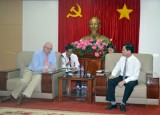With a population of about 6.6 million, the Vietnam landlocked neighbour to the west has enjoyed a high economic growth rate averaging in excess of 7% over the past few years, said Mai Thi Thuy, chair of the Association.
Laotians are now moving up into the middle income ranks, earning on average US$1,000 per year, with the retail and services sectors reporting growth and per capita spending at an all-time high, noted Ms Thuy.
The economy of Laos has been driven primarily by mining of copper, gold and silver, along with the development of major hydroelectric power plants. These industries are largely dominated by Chinese investors.
China is by far the largest foreign investor in Laos, having invested US$6.7 billion into over 760 projects in mining, hydropower, agriculture, finance, shopping centres, and special economic zones, according to the best figures available.
However, investors from Japan, the Republic of Korea (RoK), Thailand and Malaysia also have a strong presence in Vientiane, the capital of Laos, particularly in the automobile, real estate, construction, finance and retail markets.
The foreign competition in Laos seem to have a consistently better marketing strategy than local firms, said Ms Thuy.
One would think, that due to the closeness in proximity of the two nations and similarities in culture, Vietnamese products wouldn’t have much trouble finding a foothold in the marketplace.
But it hasn’t worked out that way, Ms Thuy underscored.
According to leading market analysts, automakers from the Republic of Korea as well as retailers have successfully boosted their market shares in Laos due in large part to their much better sales promotion schemes.
For instance, up until a few years ago, consumers in Laos had to pay 30% of the actual purchase price for an auto upfront as a down payment and pay back the rest over a three-year period.
Companies from the RoK have since introduced a new system in which car buyers now pay only 10% as a down payment and the rest over five years. This has allowed them to capture a large chunk of the auto market.
RoK companies are doing a similar thing with other big ticket retail items such as electronics, appliances and furniture – they are simply doing a better job at developing business and marketing plans and giving them effect.
Le An Hai, deputy director of the Asia Pacific Market Department, pointed out that companies from Thailand also excel at marketing themselves at trade shows and on television and radio advertising in Laos.
Like Vietnam, Thailand has similarities in geography and culture, but Thai companies have the upper hand when it comes to brand recognition and trademark recognition for quality over Vietnamese goods.
Thai companies are more savvy marketers, said Ms Hai. Just about every time Vietnam holds a trade fair in Laos, a Thai group swoops in and holds a fair in the exact location shortly thereafter stealing the thunder.
Thai companies are much more aggressive and they are always out actively touting their wares in the marketplace—something that Vietnam companies just aren’t that good at.
Tran Bao Giam, trade counsellor at the Vietnam Embassy in Laos, is adamant holding that if local companies want to build market share in Laos they need to follow China’s lead and construct numerous distribution outlets such as retail stores, markets and supermarkets in Laos.
If they don’t do this, local companies will never be in a position to effectively compete with their counterparts the likes of China, the RoK and Thailand in their quest for a larger slice of the Lao retail market.
















